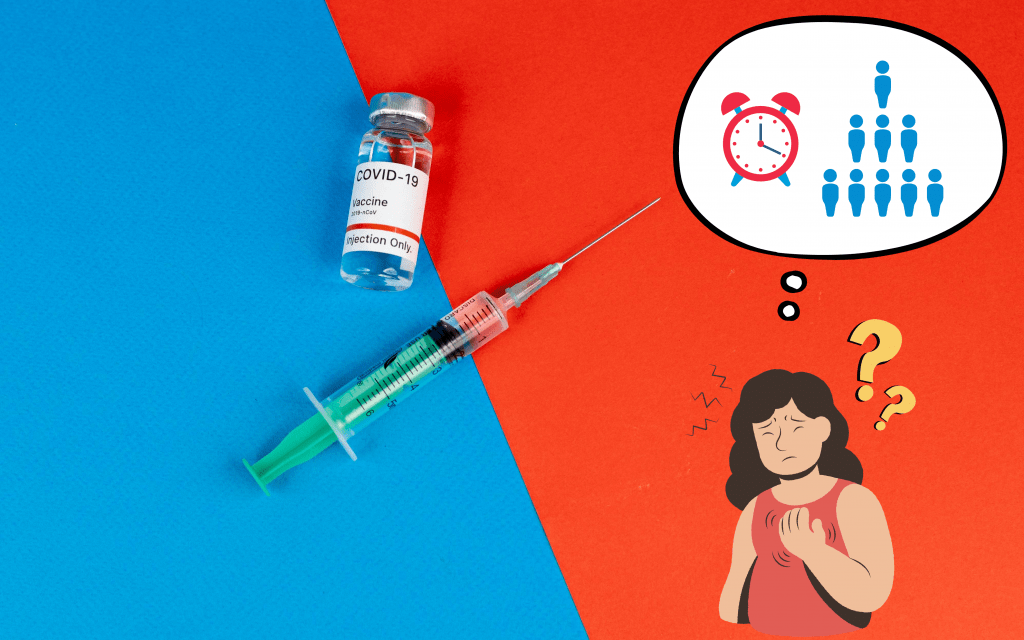
SUMMARY
Three years after the start of the COVID-19 pandemic, scientists have acquired ample evidence showing that COVID-19 vaccines are safe. While COVID-19 vaccines are associated with some serious effects like myocarditis, such cases are rare and much less likely to occur after vaccination than after SARS-CoV-2 infection.
Nevertheless, anecdotes and stories of ill health after COVID-19 vaccination posted on social media, such as the case of Maddie de Garay, continue to be used to promote the claim that COVID-19 vaccines are unsafe.
While illness can occur shortly after vaccination, it doesn’t mean that the vaccine must be the cause. Illness can also occur simply by coincidence, since diseases have existed long before vaccines arrived. Part of evaluating whether a vaccine is the cause of an illness requires determining if vaccinated people are at a higher risk of the illness compared to unvaccinated people—something that anecdotes alone cannot provide.
Introduction
Since the COVID-19 vaccines became available for adolescents and children in the U.S. and the European Union in 2021, there have been many instances of online content casting doubt on the vaccines’ safety in these age groups. Such content took many forms, including disturbing images and stories of children allegedly injured by COVID-19 vaccination.
The tactic of using distressing images and videos as evidence that COVID-19 vaccines are unsafe hasn’t been limited to children. Similar videos have been used before to imply a link between COVID-19 vaccination in adults and a variety of serious reactions, including convulsions, blood clotting, paralysis, and sudden death.
A March 2021 report by the Virality Project—a research consortium led by the Stanford Internet Observatory to study misinformation dynamics during the COVID-19 pandemic—explained that such formats proliferate because they “have strong emotional appeal”, which makes them effective anti-vaccine campaigns. However, the report said, these narratives usually distort facts by “omitting important context and reframing isolated incidents as evidence of widespread harm”.
These narratives are contradicted by scientific evidence showing that COVID-19 vaccines are generally safe and most side effects from vaccination are mild and resolve within a few days.
In this article, we will explain why not all medical events that happen after vaccination are caused by the vaccine and how experts identify those that are. We will also discuss examples of conditions and individual cases that have been misrepresented as vaccine injuries without sufficient evidence supporting such an association.
Understanding adverse events following vaccination
Unexpected deaths and health problems already existed before COVID-19 vaccines. When such events happen shortly after vaccination, it is easy to draw premature conclusions and attribute these events to the vaccine. This idea is rooted in the fact that any effect is necessarily preceded by its cause. But while a temporal association is indeed required to establish causality, this association alone is insufficient to determine whether a vaccine caused an adverse event.
Any vaccine carries a certain risk of side effects and COVID-19 vaccines are no exception. However, we have to keep in mind that an adverse event is any health problem that occurs after vaccination, regardless of its cause. Therefore, while some of these adverse events might be actual side effects (that is, caused by the vaccine), many others may manifest after vaccination simply by chance. Distinguishing between adverse events and actual side effects of a vaccine is essential for making informed vaccine recommendations.
Clinical trials are designed to identify common side effects. However, due to the limited number of people, they are often unable to detect rare side effects that occur at a very low rate in the population. Generally, such effects can only be detected post-authorization, when a high number of people get vaccinated. This is the reason why public health authorities continue to monitor adverse events even after a vaccine receives authorization.
Monitoring adverse events is essential for detecting any unusual patterns that may suggest a safety problem, and many countries have specific surveillance systems for doing so. Among those best known are the U.S. Vaccine Adverse Event Reporting System (VAERS), EudraVigilance in Europe, and the Yellow Card Scheme in the U.K.
These systems have helped identify, for example, the link between viral vector COVID-19 vaccines (Oxford-AstraZeneca and Johnson & Johnson) and the increased risk of a rare blood clotting condition in women under 60 years of age. As a result, many countries changed their vaccination guidelines, favoring alternative vaccines in that population.
Adverse event reports have also provided essential hints to establish the association between mRNA COVID-19 vaccines and a slight increase in the risk of myocarditis (heart inflammation), particularly in young males and after the second dose[1]. Awareness of this side effect has been fundamental for early detection and treatment of these cases.
However, adverse event reports alone don’t demonstrate that the vaccine caused the adverse event. Therefore, despite how anti-vaccine groups have tried to portray them, these reports aren’t a reliable catalog of vaccine side effects.
Establishing a link between an adverse event and a vaccine requires further investigations. These include evaluating whether the adverse event occurs more frequently among vaccinated people than in the general population and whether there is a plausible mechanism by which the vaccine might cause the adverse event.
Isolated cases don’t demonstrate that a vaccine is unsafe
As we explained above, rare cases of heart inflammation, Guillain-Barré syndrome (GBS), paralysis, clotting, and other conditions have occurred in people even before COVID-19 vaccines existed. For context, each day, about two new cases of childhood myocarditis and 8 to 16 cases of GBS are diagnosed in the U.S.
While these conditions are rare, the large number of vaccinations administered globally compared to other vaccines makes it more likely that some cases occur after vaccination simply by coincidence. Some groups and media outlets have weaponized these cases to promote anti-vaccine narratives that offer an inaccurate and misleading impression of COVID-19 vaccine safety.
For example, the recognition of myocarditis as a rare side effect of COVID-19 vaccines fueled misinformation exaggerating this risk and falsely linking COVID-19 vaccination with sudden deaths, particularly among young athletes.
However, the risk of developing myocarditis following vaccination is very small. In fact, it is lower than the chance of being struck by lightning, as the U.S. National Institutes of Health pointed out.
Moreover, research shows that cases of post-COVID-19 vaccination myocarditis are typically mild and unlikely to be fatal as mRNA COVID-19 vaccines aren’t associated with an increased risk of cardiac mortality or overall mortality[2].
Even before COVID-19 vaccines were available, experts in public health warned in a STAT News article that anecdotal reports could be misinterpreted by many as side effects of the vaccines, even without evidence of a causal link. Indeed, that has happened with several conditions, including Bell’s palsy and chronic inflammatory demyelinating polyneuropathy (CIDP).
CIDP is a neurological disorder caused by an autoimmune reaction against myelin, a fat and protein protective sheath that covers the nerves. Symptoms of CIDP include progressive weakness and reduced senses in the arms and legs, fatigue, and tingling or no feeling in fingers and toes.
CIDP is closely related to GBS. But while GBS causes acute symptoms from which most people recover, CIDP progresses slowly and is considered a chronic illness, even though remission is also possible. In rare cases, GBS can lead to CIDP.
Researchers aren’t sure what exactly triggers CIDP, as no apparent genetic or environmental risk factors have been identified so far. Some research suggests that previous infections and dietary habits might play some role[3].
Rare cases of GBS and CIDP have also been reported following COVID-19 vaccination[4,5], and an increased risk of GBS has been observed following vaccination with the viral vector COVID-19 vaccine from Johnson and Johnson[6,7].
However, between 7 and 80 new cases of CIDP (0.8 to 8.9 cases per 100,000 people each year) occur each day in the U.S. even in the absence of COVID-19 vaccination, according to estimates. Epidemiological studies found no evidence that these rates are higher among people who received an mRNA COVID-19 vaccine or that GBS and CIDP symptoms worsen or are more recurrent following COVID-19 vaccination[7,8-11].
Accordingly, the GBS CIDP Foundation International states that, based on current evidence, the likelihood that vaccination can trigger autoimmune neurological conditions such as GBS and CIDP is exceptionally low at best.
A matter of balancing risk and benefit
One aspect often overlooked when discussing vaccine side effects is that this risk always needs to be considered in the context of the benefits of vaccination.
Over three years of studies and safety surveillance show that side effects from COVID-19 vaccines are typically mild and short-lived. While serious side effects such as myocarditis and blood clotting are possible, they are rare—much rarer than after SARS-CoV-2 infection[12].
Bacterial and viral infections are also common risk factors for developing GBS. One study published in Neurology in October 2023 showed that the risk of developing GBS is six times higher in people with a recent SARS-CoV-2 infection compared to uninfected people. In contrast, vaccination with the Pfizer-BioNTech COVID-19 vaccines was associated with a 59% reduced GBS risk compared to unvaccinated people[13].
Besides these risks, COVID-19 carries a risk of other serious complications associated with the disease, including heart problems, damage in other organs such as the lungs, the kidneys, and the brain, and long COVID.
By reducing the risk of infection and serious COVID-19 in people, the vaccines also help reduce the risk of these potential complications. For this reason, the American Heart Association, the American College of Cardiology, and the GBS CIDP Foundation International consider that even if the COVID-19 vaccines slightly increase the risk of some of these conditions, the benefits of vaccination still outweigh the risks.
Cases of functional neurological disorder misrepresented as vaccine injuries
Soon after the COVID-19 vaccine rollout began, videos of alleged neurological problems in people who had received a COVID-19 vaccine went viral on social media.
This prompted the U.S. Functional Neurological Disorder Society to issue a press release in January 2021 stating that “many of the clinical features reported and observed on video in some cases are those of functional neurological disorder (FND)”, a condition that “can be diagnosed with good accuracy from videos on social media”. Indeed, at least one of the cases had been diagnosed with FND.
FND, formerly called conversion disorder, is a condition of the nervous system that affects how different brain areas communicate with one another, altering the way the brain functions and processes emotions. This disruption can lead to various symptoms of variable severity, such as paralysis, difficulty in swallowing, problems with hearing and vision, and problems with memory and concentration.
The term functional means that the symptoms are due to changes in the brain’s functioning, not structural damage. The U.S. National Institute of Neurological Disorders and Stroke puts it this way: “[s]omeone with FND can function normally; they just can’t at that moment”.
It is important to stress that functional doesn’t equal malingered. People with FND aren’t pretending to be ill or faking their symptoms, which they perceive as involuntary. Regardless of their origin, FND symptoms are real and can impair quality of life as much as other neurological conditions do.
Although the exact cause of FND is unknown, several biological, psychological, and social risk factors can make a person more likely to develop the condition. These include emotional and physical trauma early in life, other neurological diseases such as epilepsy, and mental health conditions such as depression or anxiety. However, not all people who develop FND have such risk factors.
Research shows that recent acute physical or emotionally charged events can trigger FND symptoms in people who have a predisposition to it. Vaccination can be one of those triggers, and cases of FND following COVID-19 vaccination have been documented[14,15].
However, claiming that the vaccine causes FND is misleading because it is the circumstances surrounding vaccination that can trigger the condition, not the vaccine itself. In fact, saline injections, which don’t contain active ingredients, have been used to induce seizures in these patients for diagnostic purposes[16].
In April 2021, neurologists and psychiatrists at Harvard Medical School and the University of Toronto published a viewpoint in JAMA Neurology pointing out that FND symptoms are indeed unrelated to the vaccine ingredients:
“FND can be triggered by physical and/or emotionally valenced events, including head injury, medical/surgical procedures, and vaccinations. These precipitating factors, while proximal to the development of the symptoms, are not directly caused by the substances in the vaccine in the same manner that, for example, Neisseria meningitidis is the cause of meningitis. Instead, factors such as expectations, beliefs, heightened bodily attention, arousal, and threat/emotional processing play important mechanistic roles in the pathophysiology of FND.”
The case of Maddie de Garay
One popular example of a story that has been shared to support misinformation about the alleged harms of COVID-19 vaccines is the case of Maddie de Garay.
On 21 January 2024, host Sharyl Attkisson interviewed Maddie’s mother, Stephanie de Garay, for the TV show “Full Measure”. Attkisson is a writer who has promoted anti-vaccine messages falsely linking childhood vaccination with autism in the past.
During the interview, de Garay explained that at the age of 12 Maddie had participated in the clinical trial for the Pfizer COVID-19 vaccine conducted at Cincinnati Children’s Hospital in June 2020. According to De Garay, her daughter had developed a severely debilitating illness during the trial that led to her needing a wheelchair and feeding tube. Amid interspersed distressing images of Maddie at the hospital, de Garay expressed her belief that the vaccine had been the cause of her daughter’s illness.
At the time of writing, the interview accumulated almost 400,000 views on YouTube. In addition, fragments of it spread widely on Facebook, Instagram, and X (formerly Twitter).
Many posts pointed to Maddie’s case as evidence that COVID-19 vaccines are harmful, with captions talking about “millions injured or dead” and the “fatal consequences” of “becoming experimental rats”. Some promoted products to “detox” from vaccination, something that is unnecessary because COVID-19 vaccines don’t contain toxins.
Maddie and her mother became known to the public in June 2021 after participating in a press conference held by Senator Ron Johnson. The event gathered five families who shared their stories of alleged adverse reactions to COVID-19 vaccines. Johnson had used this format before to spread unsubstantiated claims about the safety of COVID-19 vaccines in adults.
With Maddie in a wheelchair by her side, de Garay explained that her daughter started having severe abdominal and chest pain after her second vaccine dose. These symptoms later developed into paralysis of the stomach muscles, heart rate problems, memory loss, and difficulty walking.
De Garay repeated her story in a July 2021 interview with then-Fox News host Tucker Carlson, who also has a record of spreading misinformation about the COVID-19 vaccine.
The interview went immediately viral, and Maddie became a rallying point for anti-vaccine groups, some of which used images of Maddie’s condition to produce anti-vaccine ads. The case was also publicized by individuals well-known in the COVID-19 misinformation scene, including entrepreneur Steve Kirsch, scientist Robert Malone, and podcaster Daniel Horowitz. The latter referred to the COVID-19 vaccine as “Pfizer’s poison”.
But as Stephanie de Garay herself acknowledged in her public appearances, no diagnosis suggested a link between the COVID-19 vaccine and Maddie’s illness. Several doctors who evaluated the girl’s symptoms at that time diagnosed her with FND.
In her interview with Attkisson, de Garay claimed that Maddie had been diagnosed with “basically a stomachache that you can’t explain” and suggested that the diagnosis was a cover-up for vaccine injuries. Similarly, Carlson claimed that Maddie had been diagnosed with “hysteria” or “emotional problems”.
But these statements misrepresent the true nature of FND, which is a clinically recognized condition that can cause severe disability, as we noted above. The framing of Maddie’s FND diagnosis as diagnoses of “hysteria”, “emotional problems” or “stomachache” is therefore inaccurate. And as we explained earlier, the vaccine ingredients don’t cause this condition.
Towards the end of the interview, de Garay added a new piece of information; apparently, Maddie was diagnosed with CIDP in July 2022. The interview conveyed the message that this change in diagnosis confirmed that Maddie’s condition was indeed a vaccine injury.
But we explained earlier that mRNA COVID-19 vaccines haven’t been associated with an increased risk of developing this condition. Therefore, contrary to what the interview might suggest, this change in Maddie’s diagnosis also doesn’t provide evidence that the COVID-19 vaccine caused Maddie’s illness or that the vaccine is overall harmful to children, as social media posts claimed.
Conclusion
Simply because an adverse event occurred shortly after receiving a COVID-19 vaccine doesn’t necessarily mean that the vaccine caused it. Nevertheless, many have used this overly simplistic correlation to imply without evidence that COVID-19 vaccines are unsafe. But isolated cases or anecdotes don’t provide sufficient evidence to support such narratives, which often lack essential context and sometimes rely on unverified images of dubious origin.
When billions of people receive a vaccine within a short period of time, some of them will develop health issues such as myocarditis, GBS, and CIDP shortly after vaccination. Some cases may be related to the vaccine, while others might coincide with vaccination simply by chance. Determining whether there is a causal link between both events requires further investigations.
But even when an adverse event is indeed causally associated with a vaccine, this risk needs to be viewed in light of the benefits of vaccination. Cases of myocarditis and other heart problems are much less likely to occur after vaccination than after SARS-CoV-2 infection, which also carries other health risks.
By reducing the risk of infection and serious illness, COVID-19 vaccines can help prevent these risks. Therefore, public health authorities and medical associations agree that the benefits of COVID-19 vaccination outweigh the potential risks.
REFERENCES






